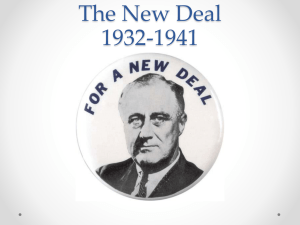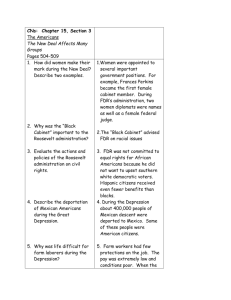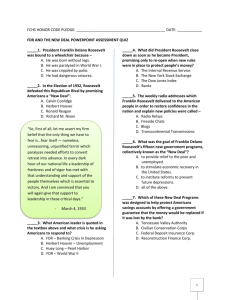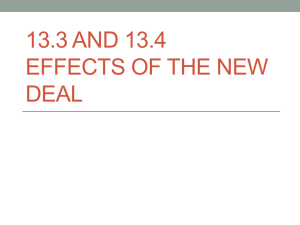(Part 1 – FDR, New Deal, Fireside Chats)
advertisement
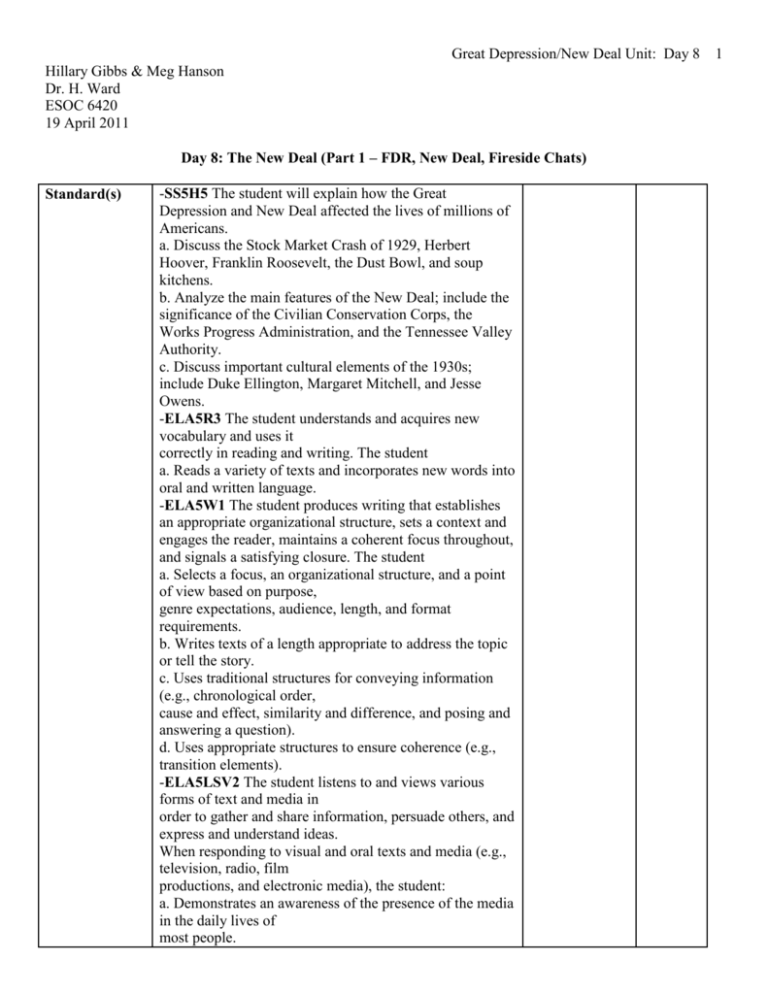
Great Depression/New Deal Unit: Day 8 Hillary Gibbs & Meg Hanson Dr. H. Ward ESOC 6420 19 April 2011 Day 8: The New Deal (Part 1 – FDR, New Deal, Fireside Chats) Standard(s) -SS5H5 The student will explain how the Great Depression and New Deal affected the lives of millions of Americans. a. Discuss the Stock Market Crash of 1929, Herbert Hoover, Franklin Roosevelt, the Dust Bowl, and soup kitchens. b. Analyze the main features of the New Deal; include the significance of the Civilian Conservation Corps, the Works Progress Administration, and the Tennessee Valley Authority. c. Discuss important cultural elements of the 1930s; include Duke Ellington, Margaret Mitchell, and Jesse Owens. -ELA5R3 The student understands and acquires new vocabulary and uses it correctly in reading and writing. The student a. Reads a variety of texts and incorporates new words into oral and written language. -ELA5W1 The student produces writing that establishes an appropriate organizational structure, sets a context and engages the reader, maintains a coherent focus throughout, and signals a satisfying closure. The student a. Selects a focus, an organizational structure, and a point of view based on purpose, genre expectations, audience, length, and format requirements. b. Writes texts of a length appropriate to address the topic or tell the story. c. Uses traditional structures for conveying information (e.g., chronological order, cause and effect, similarity and difference, and posing and answering a question). d. Uses appropriate structures to ensure coherence (e.g., transition elements). -ELA5LSV2 The student listens to and views various forms of text and media in order to gather and share information, persuade others, and express and understand ideas. When responding to visual and oral texts and media (e.g., television, radio, film productions, and electronic media), the student: a. Demonstrates an awareness of the presence of the media in the daily lives of most people. 1 Why is this lesson important? Essential Questions Daily Learning Outcomes Assessment tied to learning outcomes Vocabulary Differentiation Integration Elements Introduction Great Depression/New Deal Unit: Day 8 b. Evaluates the role of the media in focusing attention and in forming an opinion. c. Judges the extent to which media provide a source of entertainment as well as a source of information. -This lesson teaches students about FDR, the basic elements of the New Deal, why FDR created it and how it helped the United States. -Who was FDR? -Why was FDR important? -What are the basic elements of the New Deal? -How did the New Deal affect the United States? -Why was the New Deal created? -TSW to be able to explain who FDR was, why he was important, why the New Deal was created, the basic elements of the New Deal and how it affected the United States. -FDR Biography -Compare & Contrast Activity -Noting What I’ve Learned Formative Assessment -32. Franklin Roosevelt: also known as FDR; 32nd president of the US and creator of the New Deal -33. Eleanor Roosevelt: FDR’s wife -34. New Deal: a set of new programs to provide relief, reform, and recovery to America’s economy and people -35. first 100 days: during FDR’s first 100 days in office, he launched major legislation to help America’s economy and people -36. Second New Deal: new program of reforms proposed by FDR in 1935. -37. fireside chats: used by President Franklin Roosevelt to address the concerns of the American people -38. public works: projects such as building hospitals, roads, and schools to create jobs -39. relief: getting rid of a problem or stress -40. reform: to make better or change -41. recovery: to return to normal -Guided questions for FDR Biography -Encourage students to include information other than what was learned in the center in the FDR Biography -Roosevelt Rap printed lyrics -Noting What I’ve Learned Page because it allows students to both draw and write -ELA5R3 -ELA5W1 -ELA5LSV2 Procedures /Activities Resources Time -Go over the vocabulary words. Have students write the -Book -15 min word on one side of their note cards and the definition on 2 Activity Time Closure Great Depression/New Deal Unit: Day 8 the other. When they are finished, remind them to place their vocabulary words on their vocabulary word ring. -If students finish the vocabulary word ring early, there will be articles, books, pictures, and other resources spread around the room for them to look at while they wait to begin the activity. -Begin the lesson by reading the book “ Time For Kids: Franklin D. Roosevelt: A Leader in Troubled Times” by Editors of TIME for Kids with Jeremy Calpan. -Discuss FDR’s involvement in the New Deal -Tell the students we will be having centers today and introduce the various centers -Center 1: FDR - Discuss the important biographical -Computer -60 min information about FDR. Be sure to include his -Roosevelt Rap accomplishments as both a politician and president -Big Paper including the New Deal, Public Works Programs, and his -Video of radio fireside chats. Then, have the students listen to the talk from Fox Roosevelt Rap (http://www.fdrlibrary.marist. News edu/education/resources/rap.html). Give them a page with -Articles the song lyrics typed out. Have the students write a -Books biographical piece of FDR. For struggling student, -Noting What provide them with guided questions to help them know I’ve Learned what information should be included in the piece. For Activity Sheet more advanced students, encourage them to include information they may have learned in the book that we read earlier or allow them to look up extra information from other sources around the room if they desire. -Center 2: First 100 Days - First, we will have a group discussion about what exactly the “First 100 days” are. As a group, we will compare and contrast President Roosevelt and President Obama’s First 100 days in office through the use of news articles and other informational pieces. We will have a radio clip (http://video. foxnews.com/v/3919994/from-fdr-to-bho) for the students to listen to with a guided outline for them to take notes on. To close this center, we will compare and contrast as a group on big paper. -Center 3: New Deal - Have the students take turns reading passages from Chapters 4 and 5 of “FDR and the New Deal (Monumental Milestones: Great Events of Modern Times)” by Earle Rice, Jr. Then, have the students complete a Noting What I’ve Learned page throughout the activity. -The students will do a quick write of a fireside chat letter -Smart Board -15 min to send to FDR addressing a problem or issue that they -Outline for have learned about throughout the unit. For students who fireside chat are struggling, have an example of a fireside chat letter letter with an outline posted on the smart board. -If they would like, students can share with the whole group. 3 Next Steps Great Depression/New Deal Unit: Day 8 -Inform the students that we will be continuing our learning adventure about the New Deal on the following day. -Remind them to keep up with their information from today, because it can be useful in their digital storytelling project. 4

